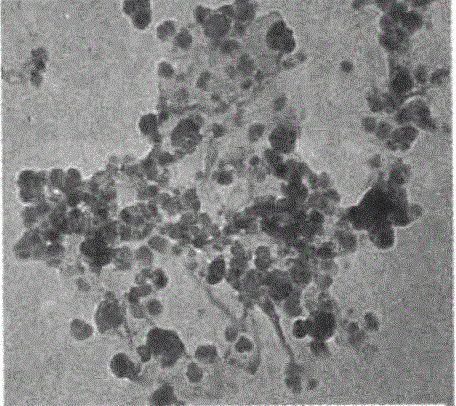Graphene catalyst
A catalyst, graphene technology, used in electrochemical generators, electrolyte immobilization/gelation, nanotechnology, etc., can solve the problems of changes in the strength and stability of the separator, complicated manufacturing processes, and limited charge and discharge life. Achieve the effect of improving safety and stability, increasing safety and stability, and prolonging service life
- Summary
- Abstract
- Description
- Claims
- Application Information
AI Technical Summary
Problems solved by technology
Method used
Image
Examples
Embodiment 1
[0030] Graphene catalyst, oligomeric clathrate silsesquioxane-graphene is prepared by the following steps,
[0031] Step 1: Weigh a portion of γ-mercaptopropyltrimethoxysilane, take an appropriate amount of absolute ethanol as a solvent, and stir evenly, according to the molar ratio of γ-mercaptopropyltrimethoxysilane:phenyltriethoxysilane 1: 1 Add phenyltriethoxysilane to the solution, stir evenly, add tetraethylammonium hydroxide to the solution according to the molar ratio of γ-mercaptopropyltrimethoxysilane: tetraethylammonium hydroxide 1:1.2, Heated to reflux for 48 hours, cooled naturally to normal temperature, evaporated the solvent by a rotary evaporator to obtain a lime milky product, washed the product with a mixed solution of tetrahydrofuran and methanol, and freeze-dried under vacuum to obtain the diamine POSS;
[0032]Step 2: Weigh a portion of graphite powder, add an appropriate amount of concentrated sulfuric acid as a solvent in an ice bath, stir, and control t...
Embodiment 2
[0035] Such as figure 1 As shown, a polymer battery includes a positive electrode sheet 1 and a negative electrode sheet 2 arranged inside the battery casing 6, a separator 5 is arranged between the positive electrode sheet 1 and the negative electrode sheet 2; A positive electrode coating 7 and a positive electrode catalytic network 3 are provided. The positive electrode coating 7 covers the surface of the positive electrode sheet 1, and the positive electrode catalytic network 3 covers the surface of the separator 5; The net 4 and the negative electrode coating 8, the negative electrode catalytic net 4 is covered on the surface of the separator 5, the negative electrode coating 8 is covered on the surface of the negative electrode sheet 2, the positive electrode coating 7 is connected with the positive electrode catalytic net 3, the negative electrode coating 8 is connected to the negative electrode The catalytic nets 4 are connected.
[0036] The positive electrode sheet 1...
Embodiment 3
[0042] Such as figure 2 As shown, the nano-Rh-graphene composite electrode was prepared by the following steps,
[0043] Step 1: Weigh a portion of graphite powder, add an appropriate amount of concentrated sulfuric acid as a solvent in an ice bath, stir, and control the reaction temperature below 20°C, according to the mass ratio of graphite powder: sodium nitrate: potassium permanganate 1 :0.5:3 Slowly add sodium nitrate and potassium permanganate to the solution, stir for 10 minutes; raise the temperature to 35°C, stir for 3 hours, add deionized water to the solution according to the volume ratio of concentrated sulfuric acid: deionized water 1:0.2 , heat up to 98°C, stir for 30 minutes, then add deionized water according to the volume ratio of concentrated sulfuric acid: deionized water 1:0.5, stop the reaction, add 5% hydrogen peroxide to the solution according to the molar ratio of graphite powder: hydrogen peroxide 1:0.2, Heat centrifugation, wash with appropriate amo...
PUM
| Property | Measurement | Unit |
|---|---|---|
| thickness | aaaaa | aaaaa |
| thickness | aaaaa | aaaaa |
| thickness | aaaaa | aaaaa |
Abstract
Description
Claims
Application Information
 Login to View More
Login to View More - R&D
- Intellectual Property
- Life Sciences
- Materials
- Tech Scout
- Unparalleled Data Quality
- Higher Quality Content
- 60% Fewer Hallucinations
Browse by: Latest US Patents, China's latest patents, Technical Efficacy Thesaurus, Application Domain, Technology Topic, Popular Technical Reports.
© 2025 PatSnap. All rights reserved.Legal|Privacy policy|Modern Slavery Act Transparency Statement|Sitemap|About US| Contact US: help@patsnap.com



